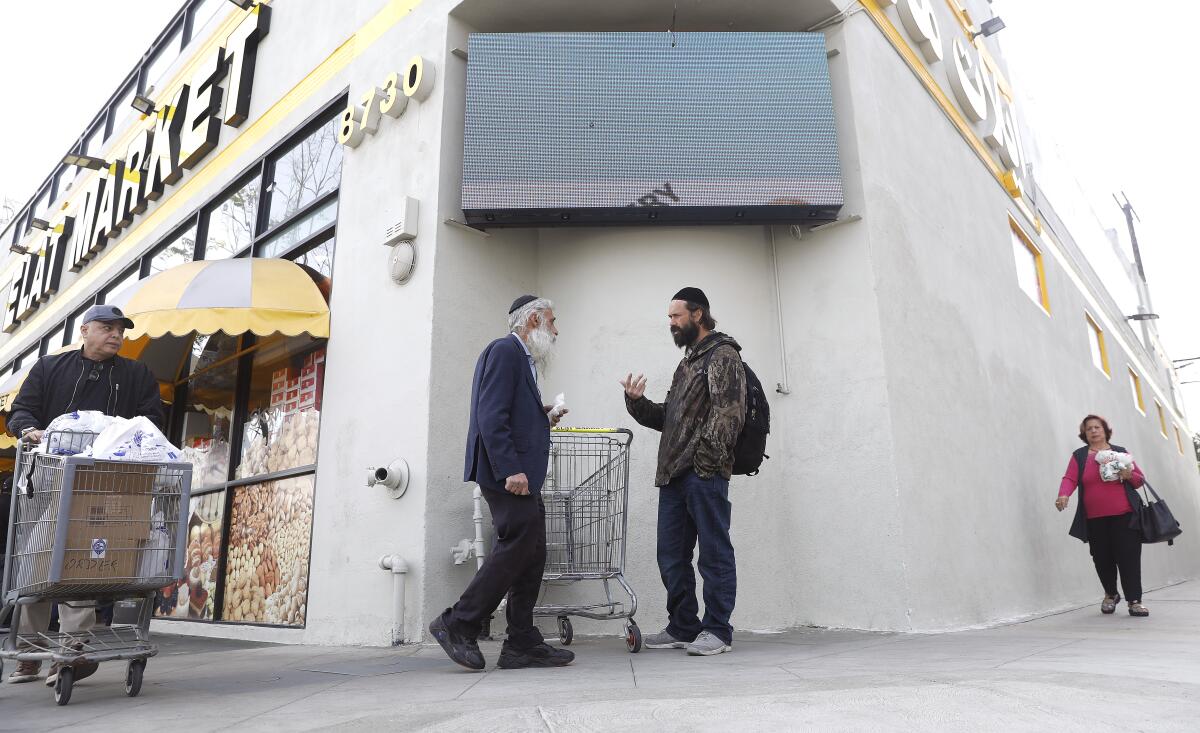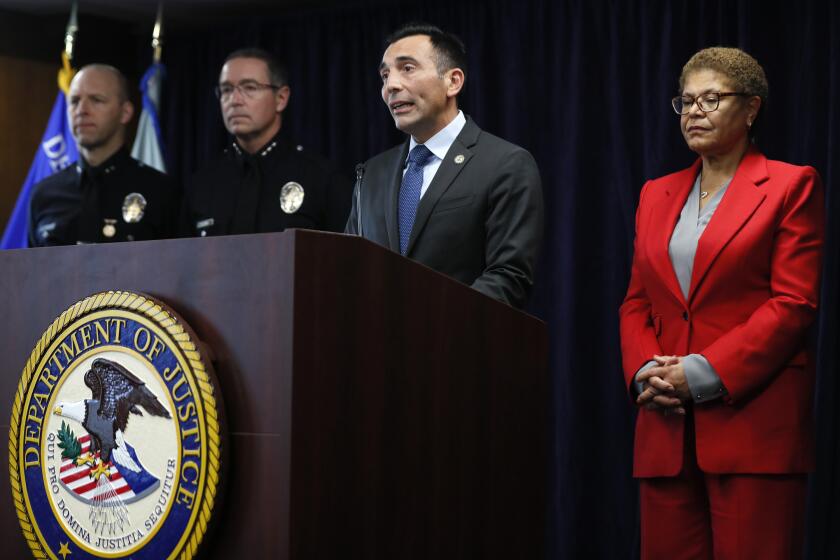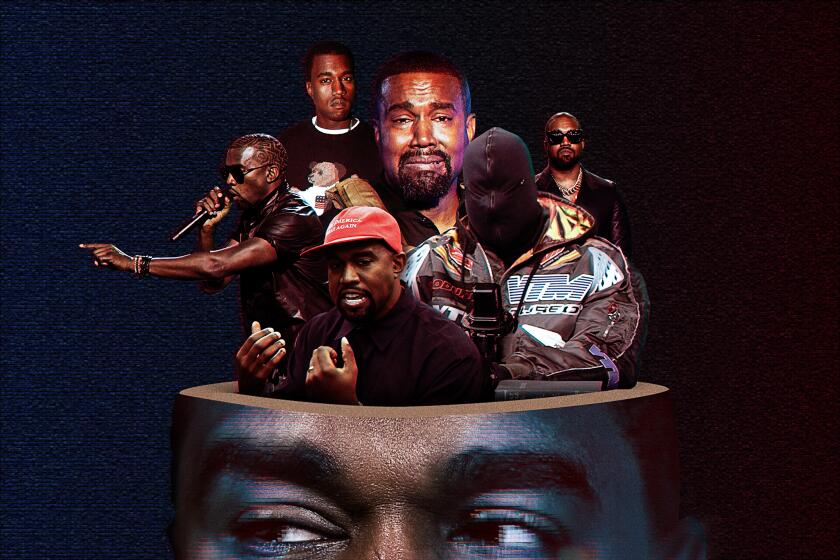Swastikas, bullhorns, guns: Antisemitic incidents in U.S. hit 43-year high, report says

- Share via
In Los Angeles, two Orthodox Jewish men were shot on consecutive mornings last month as they left religious services. Federal prosecutors said the suspect had a history of harassing Jews and searched online for a kosher deli before the shootings.
In Tucson, a professor was shot dead in October in what authorities say was an attack motivated in part by the suspect’s belief that the man was Jewish.
Outside Dallas, FBI agents killed a man early last year after he took congregants hostage in a synagogue, shouted conspiracies about Jews wielding political power and threatened to shoot his victims.
A new report suggests the acts are part of a larger trend of record levels of physical violence, harassment and vandalism against Jews that has left no U.S. city or region with a large Jewish population untouched. The Anti-Defamation League said its tally of physical assaults was the highest it has ever logged.
The civil rights organization, which identifies antisemitic incidents by researching reports from police, victims and news organizations, found that 139 Jews were physically assaulted in 111 incidents last year. The vast majority of the assaults last year did not involve deadly weapons. Still, the totals were up from 131 assault victims in 88 incidents in 2021.
“It’s extremely concerning that antisemitic incidents are growing more violent,” Jonathan Greenblatt, the group’s chief executive, said in an interview. “Orthodox Jews, who typically are more easily identifiable than other members of the Jewish community, were disproportionately targeted in 2022, and there was a corresponding increase in incidents that target Jewish spaces.... The idea that we are no longer safe in our synagogues, our shuls, or our communal spaces is simply unacceptable.”
In total, the ADL found 3,697 incidents of antisemitism last year in the U.S., including vandalism and harassment in addition to assaults. The number, the highest the group has counted since it began compiling reports on anti-Jewish hatred in 1979, represents a 36% increase from 2021. That year also set a record with 2,717 incidents, while 2020 showed a slight year-to-year dip, probably because of the slowdown of public life due to pandemic-related closures of houses of worship, businesses and workplaces.
Before the shootings, Jaime Tran had been charged with carrying a loaded firearm and was investigated after threats were sent to former classmates.
Overall, the ADL said, the pattern over the last several years has been one of growing violence, vandalism and rhetoric aimed at Jews. The group logged 2,107 antisemitic incidents in 2019 and 1,879 in 2018. The 2018 numbers included the deadliest antisemitic attack in U.S. history, at the Tree of Life congregation in Pittsburgh in which 11 were killed. In 2019, there was another deadly mass shooting, at the Chabad of Poway in California.
Last year’s incidents took place in every state and the District of Columbia, but five states — all with significant Jewish populations — accounted for more than half of them. New York was first, with 580, followed by California with 518. New Jersey, Florida and Texas rounded out the top five.
Nearly half — 237 — of those in California were in Los Angeles, Riverside, San Bernardino and Kern counties, a 30% increase regionally from the 182 incidents in 2021 and more than tripling since 2017, the ADL said.
For physical assaults, New York City — home to the nation’s largest Jewish population — repeatedly was a site of violence. More than half of last year’s assaults happened in the city and most of those targeted Orthodox Jews, while other types of incidents were more widely spread out, the ADL said.
Vandalism or harassment accounted for 97% of all incidents, according to the report. That included handing out antisemitic propaganda, a longtime strategy of extremist groups, which drop pamphlets at college campuses, synagogues and individual doorsteps across the country.
White supremacist propaganda distribution more than doubled last year, the ADL said, with 852 incidents. Vandalism, including numerous instances of property damage against synagogues and Jewish schools, was up by more than half, with 1,288 instances. And the ADL said swastikas were more prevalent than in previous years, with the symbols used in 792 acts of vandalism.
“We know that there is a serious threat against Jewish people in this country. We know that it is growing each and every year,” Greenblatt said. “And we know that what starts by targeting Jews rarely stops there.”
Jewish communities in the U.S. have long been on alert for violence and harassment, though many over the years have increased security measures and spoken of a greater sense of danger after the mass shootings at California and Pennsylvania congregations and a growing number of less violent events targeting Jews.
To get into Temple Isaiah in Los Angeles, visitors must find their way around a brick wall that separates the synagogue from the street, get buzzed through a gate, and avoid setting off suspicion among guards who protect the facility with guns.
“We were closed when the pandemic started, of course, and now we are in this era of places being open again. But I’ve spoken to a small handful of people that don’t feel safe to come,” said Rabbi Beth Singer of Congregation Emanu-El in San Francisco, an 1,800-member family Reform tradition synagogue that employs guards and requires visitors to pass through metal detectors.
“Jews tend to walk around with a sort of armor, a way of being vigilant and aware, but at the same time many people recognize that this is not the Middle Ages or the Holocaust and things are generally safe. Still, the trend toward violence and hatred is disturbing,” Singer said.
In Florida, Rabbi Yosef Konikov of the Chabad of South Orlando said his community has been dealing with occasional anti-Jewish opposition since he opened the Orthodox synagogue in 2000. But in the last two years, he said, antisemites have become more “brazen,” showing up at his center to loudly harass Jews.
Last month, videos went viral online of members of a hate group shouting through bullhorns at congregants arriving or leaving the synagogue, telling them to “go back to Israel” or screaming, “Heil Hitler!”
“Generally speaking, we live in a time when antisemitism is no longer acceptable, and I believe that 99.9% of people are in support of us and good,” Konikov said. “At the same time, I can’t argue with the numbers. It is getting worse.
“People are becoming more brave and brazen to express antisemitism,” he said. “These feelings they may have had but not displayed they now will shout at us. Still, just days after these men came to us there were so many people from the Orlando area who responded by showing up outside again, but this time to show us support.”
The trend in antisemitism in part reflects earlier waves as a response to public figures and global events, said Gunther Jikeli, associate director of the Institute for the Study of Contemporary Antisemitism at Indiana University Bloomington.
“During Sept. 11 and the Iraq war, there were conspiracies that somehow blamed both on Jews,” Jikeli said. “There is a long history of people buying into anti-Jewish stereotypes and ideas of power, seeing something they do not like and then blaming it on Jews.”
As an example, Jikeli mentioned Ye, the hip-hop and fashion artist formerly known as Kanye West who went on a series of public rants last year on social media and TV promoting stereotypes about Jewish people, denying facts about the Holocaust and praising Hitler.
West hit a new low Thursday by appearing on Alex Jones’ show with white supremacist Nick Fuentes. What’s behind his spiral from hip-hop hero to far-right troll?
From Oct. 11 — two days after the rapper tweeted “I’m going death con 3 On JEWISH PEOPLE” — through the end of the year, the ADL found 59 antisemitic incidents that included direct references to Ye. The majority involved harassment.
They included one in November in which a Northridge man said he was attacked, told to remove his kippa and asked how he felt about Ye, according to the ADL. In another instance, workers at a Jewish-owned L.A. restaurant said they received a call in December asking for the “Kanye special” before the caller said “death to all the Jews,” according to the ADL, which said both incidents were reported to police.
The ADL’s report included hate crimes in addition to verbal assaults and other acts that are offensive but not illegal.
At Cal State San Bernardino’s Center for the Study of Hate and Extremism, researchers have crunched numbers from dozens of the biggest cities using state-level and local law enforcement data to find trends that are similar to the ADL’s findings when it comes to targeting Jews.
Looking at 21 cities that include those with the biggest Jewish populations, the center found anti-Jewish hate crime cases rose last year to 470, an increase of 28%.
“Our data is roughly in line with that of the ADL and illustrates that antisemitism is getting more public and violent,” said Brian Levin, who directs the center. “There is unfortunately a universality to modern antisemitism that afflicts nations around the world, not only here in the U.S., driven by religious and ethnic nationalism, political conspiracy theories, declining trust in domestic institutions and misdirected scapegoating of diaspora Jews for the policies of the Israeli government.
“The increasing prevalence and acceptance of anti-Jewish canards fuels stereotypes that manifest not only in objectionable public prejudice, but increasingly violent attacks against Jews,” Levin said. “It is heartbreaking to observe this growing phenomenon in real time.”
More to Read
Sign up for Essential California
The most important California stories and recommendations in your inbox every morning.
You may occasionally receive promotional content from the Los Angeles Times.













